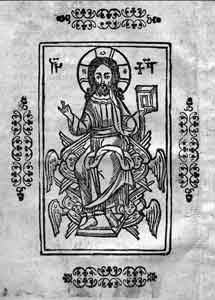 Faith & Worship
Faith & Worship So
what can an examination of the early blossoming of Christianity in the
fringes of Britain and Ireland bring to our spiritual lives today?
So
what can an examination of the early blossoming of Christianity in the
fringes of Britain and Ireland bring to our spiritual lives today?
As Christians we have firstly to realise that it is not just we who look
to the past and to a heritage handed down from our Celtic ancestors. In
this post-modern world Celtic legend is the strongest single source in
the current revival of interest in paganism. However, in the same way
that followers of paganism find it difficult to acknowledge the flowering
of Celtic culture that took place within Celtic Christianity, so admirers
of the early Celtic Church can be troubled by collections of Celtic prayers
and blessings containing charms and curses.
So it is, I feel, that we need to rid ourselves of some of the romanticism
that has been handed down concerning the early Christian saints, and whilst
acknowledging the influence that they undoubtedly had on the early Christian
communities, concentrate on those elements of their faith, doctrine and
lifestyle that can bring illumination and spiritual growth into our own.
We are not seeking to live in the past, or drift toward paganism but take
what is valuable from our Christian heritage and bring it into a contemporary
setting, where Christianity struggles not against invasions of Angles,
Jutes and Saxons, but against the enemies of indifference, denominationalism
and rejection.
In an age where time is money, and lack of time a serious problem for
so many; where the stresses and strains of daily living take their toll
both physically and spiritually it is not difficult to see the attraction
of a way of faith that finds time to be alone with God; that is God-centred
rather than self or work-centred and which brings both beauty, truth and
wholeness into lives that are, if not empty certainly not as fulfilled
as they might be.
If we sift the wheat from the chaff and look at elements that the early
monastic Church brings to us then we see the following general features:
· A genuine love of nature and a passion for God’s creation,
coupled with a sense of closeness between the natural and supernatural.
· A love of art and poetry, seen within surviving illuminated Gospels
and other works.
· Although they seem to have been theologically orthodox, there
was a distinct emphasis on the Trinity, respect for Mary the Mother of
Christ, the Incarnation and the use within worship of early forms of liturgy.
· Within their religious life we see an emphasis on solitude, pilgrimage
and mission, sacred locations and tough penitential acts.
· There were few boundaries between the sacred and the secular
· We see an emphasis on family and kinship ties.
· There seems to have been greater equality for women than we see
generally in the Church today.
· A generous hospitality was an important part of everyday life.
If we look at these characteristics we can perhaps see influences from
both pagan and Christian beliefs. We might disagree with some, disregard
others, but there are elements here which challenge our faith, call us
to examine that which we have become comfortable with, and look again
at how we might learn to part the curtain that has separated us from our
Christian heritage and take from the past that which can enable us to
grow spiritually today.
We might also find that in doing so we can begin to connect with a culture
that cannot connect with the denominational jigsaw that is the Church
to which we belong, but is seeking to follow a spiritual path which until
now has often only been catered for by other faith systems or new age
philosophies.
It matters not whether we can claim Celtic roots or not, it is within
the scope of all of us to look at the landscape with spiritual as well
as physical eyes, and begin to appreciate it for what it is and for the
way that it influences our understanding both of ourselves and our Creator.
A growing passion for the beauty of the world in which we work can lead
to a renewal in our attitudes to the mundane tasks that we face day be
day.
We can acknowledge the importance of friendship in our lives, and appreciate
how the love of our friends mirrors the love and companionship of God,
and as our faith begins to show forth new growth our journey can begin
to take us from the familiar into more challenging circumstances –
into mission. If you want inspiration then consider Brendan the Navigator
whose voyage was immortalized by Bede. In the sixth century legend has
it that Brendon took to the sea, travelling without oars and without sails,
navigating the storms of life, and trusting in faith to carry him through.
He may, or may not have landed in North America.
I quote from the Iona Community:
‘The past is all around us. We are the inheritors of the Celtic
tradition, with its deep sense of Jesus as the head of all, and of God's
glory in all of creation. So we use prayers from the Celtic Church for
welcome, for work, and in expressing the needs of the world. We are the
inheritors of the Benedictine tradition, with its conviction that 'to
work is to pray', its commitment to hospitality, and its sense of order,
all reflected in our services and our lifestyle...’ The Iona Community
Worship Book, Wild Goose Publications, Glasgow, 1991
Celtic Christianity (historical)

©John Birch · Prayers written by the author may be copied freely for worship. If reproduced elsewhere please acknowledge author/website
Privacy Policy · Links · Author · Donate